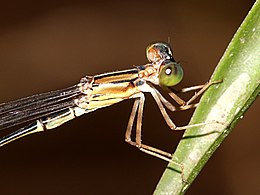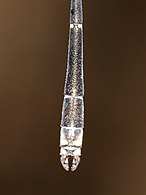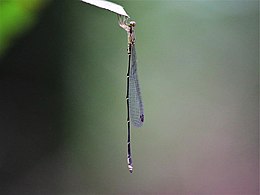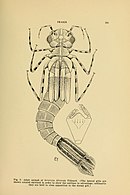Oristicta filicicola
| Slender wiretail | |
|---|---|

| |
| Slender wiretail Oristicta filicicola, Cairns, Australia | |
| Scientific classification | |
| Domain: | Eukaryota |
| Kingdom: | Animalia |
| Phylum: | Arthropoda |
| Class: | Insecta |
| Order: | Odonata |
| Suborder: | Zygoptera |
| Family: | Isostictidae |
| Genus: | Oristicta |
| Species: | O. filicicola
|
| Binomial name | |
| Oristicta filicicola | |

| |
Oristicta filicicola is a species of damselfly belonging to the family Isostictidae.[3] Until 2017 it was the only species of the genus Oristicta.[4] Commonly known as a slender wiretail,[5] it is a slender and dull-coloured damselfly of medium-size.[6] It is endemic to north-eastern Australia, where it inhabits streams in rainforests.[7]
Description
[edit]Body
[edit]Oristicta filicicola has olive-green eyes widely spaced on a small head. The synthorax is pale on the lower surface, graduating to a light green on the sides, with dark markings along the sutures. The upper surface is brown, outlined in black on the edges. The dorsal carina (mid-line ridge) is white on a dark background. The abdomen is long and slender, with a steel-like metallic-black on the upper surface, sharply cut off to cream ventral surfaces. At each segment join the paler colour sweeps up forming a narrow ring. On segments 9 and 10, the pale coloration sweeps up towards the rear, to form a dark wedge-shaped pattern on both segments. From a sample of twenty-six specimens held in the Commonwealth Scientific and Industrial Research Organisation, the average length from head to tail tip was 45 mm.[8] The superior anal appendages of the male are club shaped and curve inwards. The inferior appendages are about half as long. In the female, the ovipositor is black and there are two small diverging filaments forming a “v” shape. The appendages are short and pointed.[2]
Wings
[edit]The wings are transparent with dark veins and the average wing span is 50mm.[8] The pterostigma near the wing apex are dark grey outlined with black, measuring just more than half the length of the cell above which they are positioned. The forewings and hindwings are similar in layout. Postnodal crossveins number 12–14 in the forewing and 11–13 in the hindwing. Diagnostic features which distinguish Oristicta from other genera include the crossvein (Ac) being located between (Ax1) and (Ax2) but closer to (Ax1), and the median sector diverging after the nodal crossvein.[2]
Gallery
[edit]-
Oristicta filicicola detail of head and synthorax, Cairns
-
Dorsal view of head and synthorax
-
The superior (upper) appendages are longer than the inferior (lower) appendages in the Slender wiretail. This is a male.
-
Dorsal view of male abdomen end and appendages
-
Profile view of a male
-
Illustration of Oristicta wing veins
-
Photo of female wings
-
Adult nymph of Oristicta filicicola
References
[edit]- ^ Dow, R.A. (2017). "Oristicta filicicola". IUCN Red List of Threatened Species. 2017: e.T14675965A59256808. doi:10.2305/IUCN.UK.2017-1.RLTS.T14675965A59256808.en. Retrieved 19 November 2021.
- ^ a b c Tillyard, R.J. (1913). "On some new and rare Australian Agrionidae (Odonata)". Proceedings of the Linnean Society of New South Wales. 37 (1912): 404–479 [438]. doi:10.5962/bhl.part.22352 – via Biodiversity Heritage Library.
- ^ Schorr, Martin; Paulson, Dennis. "World Odonata List". Slater Museum of Natural History. University of Puget Sound. Retrieved 9 November 2017.
- ^ "Species Oristicta filicicola Tillyard, 1913". Australian Faunal Directory. Australian Biological Resources Study. 2012. Retrieved 3 April 2017.
- ^ Theischinger, Günther; Hawking, John (2006). The Complete Field Guide to Dragonflies of Australia. Collingwood, Victoria, Australia: CSIRO Publishing. p. 74. ISBN 978-0-64309-073-6.
- ^ Watson, J.A.L.; Theischinger, G.; Abbey, H.M. (1991). The Australian Dragonflies: A Guide to the Identification, Distributions and Habitats of Australian Odonata. Melbourne: CSIRO. ISBN 0643051368.
- ^ Theischinger, Gunther; Endersby, Ian (2009). Identification Guide to the Australian Odonata (PDF). Department of Environment, Climate Change and Water NSW. p. 230. ISBN 978-1-74232-475-3.
- ^ a b "Atlas of Living Australia – Oristicta filicicola". Retrieved 12 April 2017.









